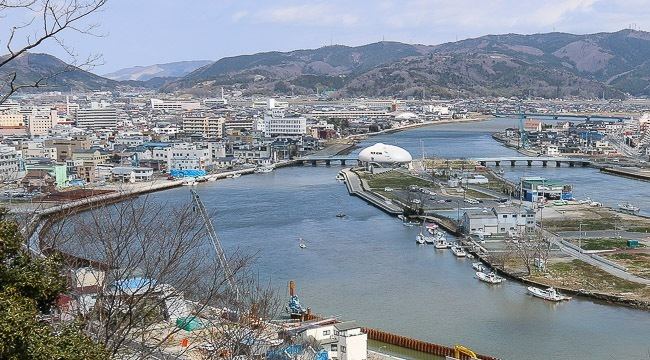Population 160,826 (2010) | - Tree Japanese Black Pine Local time Thursday 9:35 AM | |
 | ||
Weather 6°C, Wind NW at 32 km/h, 66% Humidity Points of interest | ||
Tsunami in ishinomaki miyagi prefecture japan 2
Ishinomaki (石巻市, Ishinomaki-shi) is a city located in Miyagi Prefecture, in the Tōhoku region of northern Japan. As of September 2015, the city has an estimated population of 145,805 and a population density of 263 persons per km². The total area was 554.50 square kilometres (214.09 sq mi).
Contents
- Tsunami in ishinomaki miyagi prefecture japan 2
- Map of Ishinomaki Miyagi Prefecture Japan
- Miyagi vlog ishinomaki manga museum and matsushima bay ft kim dao abroad in japan okanotv
- Geography
- Neighboring municipalities
- Climate
- History
- 2011 earthquake tsunami and subsidence
- Economy
- Education
- Railway
- Intercity bus
- Highways
- Seaports
- Local attractions
- International
- Japanese sister cities
- Noted people from Ishinomaki
- References
Map of Ishinomaki, Miyagi Prefecture, Japan
Miyagi vlog ishinomaki manga museum and matsushima bay ft kim dao abroad in japan okanotv
Geography
Ishinomaki is in northeastern Miyagi Prefecture. The city borders on Matsushima Bay to the south and Kesennuma Bay to the north. Its coastline forms part of the Sanriku Fukkō National Park, which stretches north to Aomori Prefecture. Ishinomaki includes Tashirojima (aka Cat Island), Ajishima, and Kinkasan, three islands off the south coast of Oshika Peninsula.
Neighboring municipalities
Climate
Ishinomaki has a humid subtropical climate (Köppen climate classification Cfa) with warm summers and cold winters. Precipitation is significant throughout the year, but is heaviest from June to October.
History
The area of present-day Ishinomaki was part of ancient Mutsu Province. During the Sengoku period, the area was contested by various samurai clans before the area came under the control of the Date clan of Sendai Domain during the Edo period, under the Tokugawa shogunate. The town prospered as a major port and transshipment center for coastal shipping between Edo and northern Japan. The town of Ishinomaki was established on June 1, 1889 with the establishment of the municipalities system.
The modern city was founded on April 1, 1933. On April 1, 2005, Ishinomaki absorbed the neighboring towns of Kahoku, Kanan, Kitakami, Monou and Ogatsu (all from the former Monou District), and the town of Oshika (from Oshika District) to more than quadruple its area and add nearly 60,000 people to its population.
The town of Ogatsu is regionally famous for its inkstones and has an annual scallop festival in the summer. Ayukawa, a town in Oshika, was formerly a base for several ships in Japan's whaling fleet.
2011 earthquake, tsunami, and subsidence
Ishinomaki was among the municipalities most seriously affected by the 2011 Tōhoku earthquake and tsunami. Several tsunamis, up to about 10 metres (33 ft) high, traveled inland up to 5 kilometres (3.1 mi) from the coast. The tsunami destroyed around 80% of the 700 houses in the coastal port of Ayukawa, and the Kadonowaki neighborhood was largely leveled. Approximately 46% of the city was inundated by the tsunami. Following the tsunami, a Kamen Rider statue was found completely intact despite damage to the surrounding area; a writer for Tokyo Sports hoped that it would symbolically give hope to the survivors of the disaster.
Many public schools were completely destroyed, including Ishinomaki Okawa Elementary School (大川小学校), which lost 70 of 108 students and nine of 13 teachers and staff There is still anger among some of the parents of the dead students because the teachers had wasted precious time in debating whether to evacuate to higher ground. And when the decision was finally made, the teachers had decided to get to higher ground further away from the school which necessitated crossing a nearby river bridge. It was here while crossing the bridge that both the teachers and students were swept away by the tsunami. This decision is deemed unreasonable by many of the parents because there is a hill right behind the school, which they could have reached quickly. One of the teachers had tried to persuade the other teachers to bring the students to safety uphill soon after the earthquake; when he was unsuccessful, he evacuated himself, managing to persuade one of the students to go with him - both survived. One of the teachers who survived the tsunami at the bridge later committed suicide.
As of 17 June 2011, a total of 3,097 deaths had been confirmed in Ishinomaki due to the tsunami, with 2,770 unaccounted for. Approximately 29,000 city residents lost their homes.
Ishinomaki employs several foreigners to teach English in all of its elementary and junior high schools, as well as the two municipal high schools. American teacher Taylor Anderson was killed by the tsunami. Since her death, her family has been active in supporting the Ishinomaki school district, and has set up programs to further English education.
The earthquake shifted the city southeast and downward, lowering it by as much as 1.2 metres (3.9 ft) in some areas and causing it to flood twice daily at high tide. A once sandy beach in the Kadonowaki area completely disappeared and tides now reach the wall that once separated the beach from the road. Near the Mangakan Island, a walkway with benches was partially submerged in the river.
Economy
Ishinomaki traditionally has been a center for commercial fishing, especially for the cultivation of oysters.
Education
Railway
Intercity bus
Daily scheduled intercity buses bound for the following cities, through the Sanriku Expressway, are being served from Ishinomaki Station.
